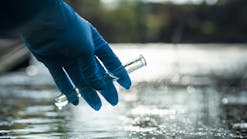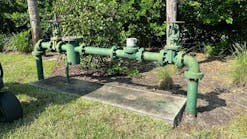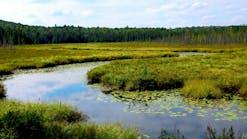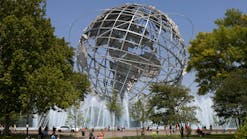Conference Highlights
Top Notch Education (Times Two)
This year’s Environmental Connection will be held in Portland on February 15–18, 2015. The event will host the usual roundup of educational sessions, exhibit hall, networking opportunities, and a cast of characters from the erosion, sediment, and stormwater community. In addition, we are co-hosting with IFAI’s Geosynthetics 2015 conference. This means there will be even more educational value to you, as you can attend educational sessions for either group with one admission price. As usual, our instructors are the best of the best. You will earn Professional Development Hours by attending the technical sessions and any of our full-day courses.
Full-Day Courses
Getting to Know RUSLE2
Presented by: David Lightle, CPESC #651
Stream Restoration Planning and Design:
Essential Basics for the Erosion Control Professionals
Presented by: Dr. David Williams, PE, CFM, PH, CPESC
Navigating Stormwater Compliance with Budgets,Schedule & Solutions
Presented by: Mary A. Larsen, TOR, QSD, CPSWQ, CPESC and Jennifer Hildebrand, CPESC, CPSWQ
Mastering the Art of Phase II MS4 Program Effectiveness & Compliance
Presented by: J.B. Dixon, CISEC, CPESC and Carrie Powers, CPESC
Bio-Technical Remediation and Soft Armor Installations for High Velocity Urban Channels
Presented by: Jerry Sanders, CPESC and Hector Sotelo, PE
Effective Best of the BMPs
Presented by: John McCullah, CPESC
Steep Slope Stability Analysis
Presented by: Stanley Miller, PE, CPESC
Over 115 Technical Sessions
Inspiring case studies, thought-provoking forums, and original research make up Environmental Connection 2015’s technical sessions. Learn proven techniques to help you stay ahead in a competitive market. These sessions are included with the purchase of any conference pass. The sessions are presented in a variety of formats such as:
- Training Workshops
- Case Studies
- Forums
- Technical Papers
- Product Practicums
- Poster Presentations
- Half-Day Sessions
EXPO HALL
We will be celebrating the Expo Hall opening at our Mardi Gras-themed Opening Reception. The exhibit hall will be much larger and have a variety of new vendors to check out. There will be a new feature in the Expo Hall this year, called the IECA Town Hall. There attendees can find our job boards (post jobs or résumés), poster sessions (where the authors will be taking time to explain their projects), the SOIL Fund silent auction, and a nice quiet area to meet with potential customers or employers. This year’s hall will be shared with the Industrial Fabrics Association International’s Geosynthetics 2015 attendees. This means one giant exhibition—all under one roof.
SPECIAL EVENTS YOU WON’T WANT TO MISS
Keynote Breakfast
Kick off the Environmental and Geosynthetics Connection conferences with the official welcome and dual keynote presentations featuring an in-depth look at the Oso, WA, landslide, implications for the future, and the rebuilding efforts.
Oso Landslide Causes, Implications and Prevention Options
Presented by: Professor Scott Burns, Ph.D., University of Oregon
In March 2014, an incredible landslide happened about midday in rural Oso, WA (NE of Seattle), and killed 43 people. It traveled over 60 miles an hour and crossed the whole valley. It is the most devastating landslide (number of people killed) in modern American history. It occurred in an area where there had been 10 major landslides in the last 6,000 years. Geologists knew of this past history, but this knowledge was not translated to planners well, and people were allowed to live in landslide-prone areas. This landslide is being studied from many angles today: prediction, planning, mechanisms, insurance, and many more. It has become one of the most significant case histories to be studied by geotechnical engineers and engineering geologists in the last 50 years.
Reconstruction of State Route 530 After the 2014 Oso Landslide
Presented by: Shaun Stauffer, Principal, GeoEngineers, Inc.
This presentation will discuss the Oso landslide event, the resulting damage to State route 530 and associated facilities, and the emergency design and final reconstruction of the roadway.
Field Tours
IECA will offer two field tour options during Environmental Connection.
Field Tour T: Johnson Creek Stream Restoration on Tuesday, February 17, 2015
Johnson Creek is Portland’s largest tributary to the Willamette River and is home to fish species listed as threatened under the Endangered Species Act. The creek also has a long history of flooding problems causing major property damage and multiple, but unsuccessful, attempts at addressing the problems. The most significant changes occurred during the 1930s when the Works Progress Administration widened, deepened, and rock-lined 15 of the 26 miles of the creek. In 1997, the city of Portland began purchasing property along the creek from willing sellers.
This field trip will examine a variety of types and sizes of facilities constructed with private and public funds as well as public-private partnerships. On the field trip, we will discuss the planning process behind siting facilities, realized cost savings, direct and indirect benefits, and the city’s approach to engaging the public. The field trip will be led by representatives of the city’s Sustainable Stormwater Program.
Mardi Gras Celebration–Expo Hall Style!
Tuesday Lunch
After a morning of education join us for lunch in the Expo Hall, which will be followed by an afternoon connecting with exhibitors (both from Environmental Connection and Geosynthetics) in our Expo Hall. The exhibit hall will be open from 9:00 am to 5:00 pm.
Wednesday Expo Hall Lunch
Product Practicums
Product Practicums are back! These 30-minute sessions give attendees a chance to see the latest and greatest products and services by our vendors. This year the following companies will be demonstrating their best: Profile Products, SedCatch, Flexamat, Applegate Mulch, EvirolokWest, PermaMatrix, and Sunmark Environmental.
Learning Lab
IECA will host a Learning Lab in the Expo Hall. This gives attendees the opportunity for an interactive and engaging educational experience. The lab will be a Product Learning Lab with various companies doing live demonstrations. The products will come from companies that include Hamilton Manufacturing, Milliken, WTB, Inc., Applied Polymer Systems, datMobile, RoLanka, and Sustane Natural Fertilizer.
SOIL Fund Silent Auction
The proceeds from this event will be donated to IECA’s charitable fund, Save Our International Land (SOIL). The SOIL Fund provides a permanent funding source for programs and projects that improve environmental quality through education, research, and applied technology. The SOIL Fund Auction will be held in the Expo Hall. If you would like to donate to the auction, contact Georgina at [email protected].
Hotel & Travel Info
Conference Location
The Environmental Connection and Geosynthetics 2015 conferences will be held at the Oregon Convention Center in Portland, Oregon.
Hotel Info
IECA wants to help you plan your trip to Environmental Connection 2015 in Portland, Oregon. ConferenceDirect is the only official housing provider for the Environmental Connection & Geosynthetics 2015 Conferences. Since the conference will be held at the Oregon Convention Center, you have a variety of hotels to choose from. From now until February 5, take advantage of the IECA group rate of offered at various hotels near the Oregon Convention Center. To book your hotel reservations, visit www.ieca.org/travel.
Getting Around
Portland has a light-rail system that even connects the airport to the convention center area and surrounding hotels. The fare is approximately $5. For more information on the light rail system, visit www.trimet.org/max.
Air Travel & Transportation
The major airport serving Portland, Oregon, is Port of Portland International Airport (PDX). View a list of airlines that serve Portland International Airport by visiting www.portofportland.com.
Member Spotlight: 10 Minutes With Pat Fallon
Each issue, IECA honors one outstanding member that has shown dedication to not only the organization, but to the erosion and sediment control industry. We honor this member to show gratitude and support for all their accomplishments. This issue, it’s our pleasure to feature an outstanding member, Pat Fallon.
Fallon has been in the industry for 33 years. This hard worker and constant learner admits his first love of earthwork and erosion and sediment control.
Q: Can you tell us a little bit about your professional experience?
A: I have an Associate of Science degree in Civil Engineering and completed the University of Tennessee Municipal Training program in Public Works and Utilities Management. I became a CPESC in 2003 and am licensed in Tennessee and Arizona in both Water Distribution and Wastewater Collections Systems. I manage the Streets, Facilities, Stormwater and Fleet Maintenance Division of the Oak Ridge Public Works Department serving a population of 30,000. I recently added the role of Stormwater/MS4 Manager to my list of duties.
Q: How did you get started in your field of practice?
A: In 1981 I began with an engineering firm that primarily serviced the coal mining industry in Tennessee and Kentucky where I learned about excavation, detention/sediment ponds, land reclamation, and stream protection. In 1987 I began my career with the City of Oak Ridge as a Public Works construction inspector before moving into operations management in 2010.
Q: Can you tell us a little bit about yourself and your life outside work?
A: I have lived in East Tennessee my entire life. My wife and I have purchased our future winter home in the Phoenix area. These areas are polar opposites with Tennessee being heavily forested with many lakes and streams compared to the desert landscape in Arizona but we find both areas to be great places in which to live and appreciate the diversity of each area. I have been married to my wife Susan for over 29 years. Our 21 year-old son passed away in 2010. Since we have very few family members near us we have an extended family that “adopted” us 25 years ago and we have a great time with our four “sisters” and their children. I am a lifelong fan of the Tennessee Volunteers, Atlanta Braves, and Miami Dolphins. I love to play golf and enjoy traveling.
Q: What drives you to succeed professionally?
A: I truly enjoy the work I do and strive to be the best that I can be. Having four different components within the division I oversee keeps me very busy, but I enjoy helping our employees make a difference as we serve the public.
Q: What is the most enjoyable aspect of your job?
A: I enjoy helping to keep our little part of the country as safe and clean as possible. Through work in the stormwater industry I am happy to be a resource for developers and homeowners who have questions concerning erosion control and effective ways to keep the waterways clean. As our city moves into the MS4 program I have an obligation as the program manager to help educate our citizens, employees, contractors, and visitors of the importance in keeping the storm sewer system in the best condition possible in order to keep the abundant streams, rivers, and lakes that are located in our area protected for wildlife, recreation, and public enjoyment.
Q: What is something people don’t know about you?
A: Starting when I was 12 I spent my summers working on my uncle’s dairy farm. I believe this is where I got an appreciation for conservation of the soil and remember being taught how to till the soil across the slope to keep the water from washing out the crops.
Q: What’s your IECA member experience?
A: I have been a member for 15 years. I went to my first conference in Nashville in the late ’90s, and immediately knew that this was an organization that had a clear vision as to what they wanted to do and that I wanted to be a part of. I enjoy the opportunity to learn from some of the most knowledgeable people in this industry who are always happy to answer even the craziest questions that I have been known to ask.
I am a member of the Southeast Chapter and they are fantastic to work with. We have many experts within the chapter that are always ready to answer any questions. We also have a lot of fun at the Environmental Connection conferences when we have our chapter functions.
Q: What are your goals to further your IECA experience?
A: I have been fortunate throughout the years to have the opportunity to moderate classes at the annual conference for some of the most outstanding presenters in our industry. This year I was honored to be chosen to serve on the Professional Development Committee and have enjoyed my brief time learning from this outstanding group of erosion control professionals and reviewing the exciting presentations that will be available at this year’s conference.
Q: What are the most impactful issues regarding erosion and sediment control today?
A: I believe that low impact development practices will have a huge impact on the industry. Over my career it is certainly much easier to get contractors to conform to erosion and sediment control requirements than it was 20 years ago.
Q: What’s your best advice you can give someone new to the industry?
A: First and foremost is join the IECA. This organization will provide you with a strong framework to begin your career and enable you to learn from the top professionals in this industry, which will give you the opportunity to create a network of support on any topic concerning stormwater issues. I can think of no better way to grow in this industry.
Q: How would you want to be remembered in the industry?
A: I would like to be remembered as a person who expected excellence from himself and everyone that I work with. Too many times we accept the minimum requirements as our standard and if you set that as your goal then mediocrity is what you will typically get. You can’t be perfect but if you strive for perfection and fall short you will still excel.
One Challenging Project
By John A. McCullah
Tuan Haji Abu Bakar is the head of JPS (Department of Irrigation and Drainage) for the state of Kedah, Malaysia. We met during some classes I taught on previous trips. He submitted a challenging problem on the Sg Pedu (Pedu River) in northern Malaysia, not far from the border with Thailand. Ultimately Leong Kwok Wing (known as Wing) and I designed and supervised the construction of the first Newbury Engineered Rock Riffle and Bendway Weir in Malaysia.
This demonstration project was an opportunity for hands-on technology transfer of new environmentally sensitive stream stabilization techniques. The engineered riffle was chosen as a cost-effective alternative to a large check dam—needed to ensure that the upstream Pedu River Irrigation Project pumps remain submerged during low flows.
The low-flow water surface elevation needed to be raised almost 2.5 meters.However the structure needed to withstand over 5,000 cfs (the Q5000 has an anticipated water surface of 2 meters over the structure). The Newbury Riffle we designed was over 40 meters long, 20 meters wide, and had a slope of about 20:1. Another design challenge was the available rock couldn’t exceed 1 meter diameter.
The project presented many construction challenges. We developed construction strategies that complied with self-imposed water-quality standards—turbidity downstream couldn’t exceed a 10 nephelometric turbidity unit (NTU) increase from the upstream sample. One morning the NTUs increased from 18 NTUs to over 1,800 NTUs in just three hours—all from the upstream watershed (illegal logging). One afternoon we received almost 6 inches of rain in less than two hours. The river rose 4 feet overnight.
JPS wanted this project to demonstrate and transfer new technology.Therefore, we also provided a one-day workshop for the JPS Kedah engineers and designers. Challenges needed to be turned into opportunities.
We used a well-graded, specifically designed rock gradation because delivery of large rock (>36 inches) was infeasible.
The poorly sorted (self-launching), homogeneously laid rock was imperative to success. Additionally, all rock in the riffle body was built from downstream to upstream and built in compression.
Construction oversight and operator training was challenging but the equipment operators were very skilled and so willing to learn—working with them was the high point of the project. The project involved the placement of almost 6,000 tons of rock and required about 35 days to build. More information available on www.watchyourdirt.com.




















